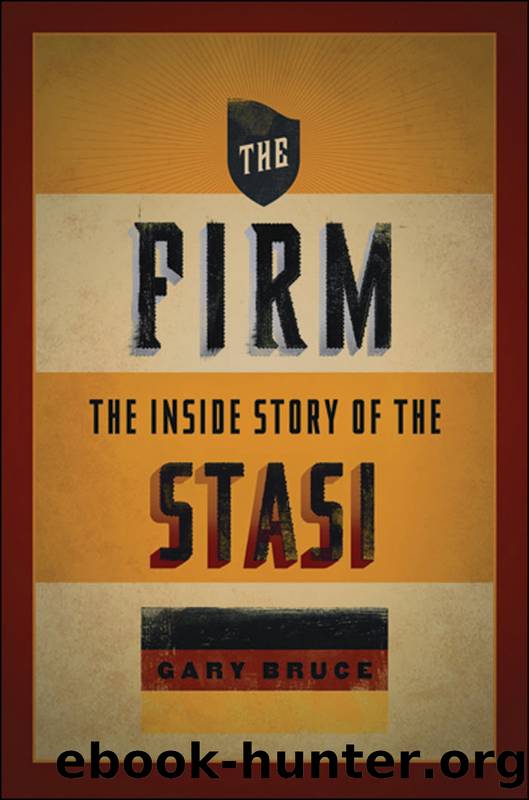The Firm by Gary Bruce;

Author:Gary Bruce;
Language: eng
Format: epub
Publisher: OUP Premium
Published: 2010-01-15T00:00:00+00:00
THE ISSUE OF COLLABORATION BEYOND INFORMANTS
To monitor any suspect, the Stasi relied on informants, mail monitoring, and telephone tapping, but another key source of information in OPKs and OVs was âofficialâ sources such as factory bosses or police officers. These individuals are sometimes referred to as Partner des operativen Zusammenwirkens (POZW, Collaborative operational partners) but more frequently as Kontaktpersonen (contact persons). In modern human resources jargon, these individuals would be considered âcasual employees,â with the important distinction that they generally did not receive payment for their efforts.
One of the saddest limitations of the Stasi Files Law that was promulgated by the all-German parliament in 1991 was that it barred former full-time Stasi employees and registered informants from public office, but did not address the issue of contact persons. One former Stasi officer complained bitterlyâand no doubt rightlyâthat it was unfair that he was banned from employment after 1989 with the public sector, indeed was vilified in the streets, because he had been a full-time Stasi officer, while his contact in the local police detachment who telephoned him on average five times per day with tips about individuals was allowed to continue as a police officer in the united Germany. These contact persons presented a challenge to senior Stasi officers who were unsure whether to classify them as informants, who would then be subject to specific directives. In 1989, Erich Mielke was forced to take a stand: âContact persons are not informants. . . . We know of cases, however, where contact persons are employed in OPKs, or where their work differs from that of an informant only insofar as one is registered, the other not.â109 It was Mielkeâs wish that informants be used on a regular basis while contacts were to be used much more sparingly.
Beyond the registered informants and the nonregistered contact persons lies a third category of collaborator, a category that might be conceived of as âirregular collaborator.â Former Stasi officers, in their highly illuminating two-volume defense of the Stasi, tangentially refer to this form of assistance to the Stasi when they write: âIt is beyond doubt: Every intelligence service depends primarily on information obtained by its informants and other âtip-givers.â â110 Although these tip-givers capture a certain type of collaboration in this category of informant, it does not fully describe individuals who performed a task or rendered a service, rather than provided information to the Stasi, like the funeral director in OV Vergeltung, whose involvement with the Stasi was limited to providing a specific service once, for a clearly defined purpose. This category would be defined by its lack of regular contact to the Stasi, and as such would have the weakest ties to the Stasi while still forming part of the repression apparatus. Although the number of registered informants is extremely high (173,000), this number does not include contacts111 nor âirregular collaborators.â It is worth stating this point explicitly: the Stasiâs network of unofficial cooperation reached far beyond the well-researched registered informants (IMs) to include contacts and irregular collaborators.
Download
This site does not store any files on its server. We only index and link to content provided by other sites. Please contact the content providers to delete copyright contents if any and email us, we'll remove relevant links or contents immediately.
| General | Channel Islands |
| England | Northern Ireland |
| Scotland | Wales |
Room 212 by Kate Stewart(4710)
The Crown by Robert Lacey(4551)
Endurance: Shackleton's Incredible Voyage by Alfred Lansing(4465)
The Iron Duke by The Iron Duke(4092)
The Rape of Nanking by Iris Chang(3998)
Killing England by Bill O'Reilly(3885)
Joan of Arc by Mary Gordon(3762)
Say Nothing by Patrick Radden Keefe(3687)
I'll Give You the Sun by Jandy Nelson(3240)
Shadow of Night by Deborah Harkness(3158)
Hitler's Monsters by Eric Kurlander(3135)
Blood and Sand by Alex Von Tunzelmann(3033)
Mary, Queen of Scots, and the Murder of Lord Darnley by Alison Weir(3020)
Darkest Hour by Anthony McCarten(3002)
Margaret Thatcher: The Autobiography by Thatcher Margaret(2954)
Eleanor & Park by Rainbow Rowell(2916)
Red Famine: Stalin's War on Ukraine by Anne Applebaum(2802)
Book of Life by Deborah Harkness(2702)
The One Memory of Flora Banks by Emily Barr(2666)
